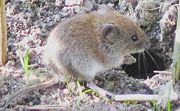Vole
2008/9 Schools Wikipedia Selection. Related subjects: Mammals
| Vole | ||||||||||||
|---|---|---|---|---|---|---|---|---|---|---|---|---|
 The bank vole lives in woodland areas in Europe and Asia.
|
||||||||||||
| Scientific classification | ||||||||||||
|
||||||||||||
| Genera | ||||||||||||
|
Arvicola |
A vole is a small rodent resembling a mouse but with a stouter body, a shorter hairy tail, a slightly rounder head, and smaller ears and eyes. There are approximately 70 species of voles; they are sometimes known as meadow mice or field mice in North America. The voles, together with the lemmings and the muskrats, form the subfamily Arvicolinae.
Description
Most vole species have rootless molars that fold into a series of triangles. Voles are one of the few rodents whose molars continue to grow during their entire life. Adult voles, depending on the species, are three to seven inches long.
Range
Species of voles can be found in Europe, Asia, North Africa and North America, and tundra areas.
Diet
Depending on the species, the vole's diet consists of seeds, tubers, conifers needles, bark, various green vegetation such as grass and clover, and insects.
Predators
Many carnivores such as wolves, owls, hawks, coyotes, foxes, weasels and cats eat voles. A common predator of voles is the short-eared owl.
Genetics and sexual behaviour
The prairie vole is a notable animal model for sexual fidelity, since the male is usually faithful to the female, and shares in the raising of pups. (The woodland vole is also usually monogamous.) Another species from the same genus, the meadow vole, has promiscuously mating males, and scientists have changed adult male meadow voles' behaviour to resemble that of prairie voles in experiments in which a single gene was introduced into the brain via a virus. The behaviour is influenced by the number of repetitions of a particular string of microsatellite ("junk") DNA, and the same DNA sequence is found in humans. Male prairie voles with the longest DNA strings spend more time with their mates and pups than male prairie voles with shorter strings. However, other workers have disputed the gene's relationship to monogamy, and cast doubt on whether the human version plays an analogous role. Physiologically, pair-bonding behaviour has been shown to be tied up with vasopressin, dopamine, and oxytocin, with the genetic influence apparently arising via the number receptors for these substances in the brain; the pair-bonding behaviour has also been shown in experiments to be strongly modifiable by administering some of these substances directly.
Voles exhibit complex genetic structures with much variation, and appear to be evolving rapidly when compared with other vertebrates. For this reason, they can be useful to archaeologists for dating strata, in a method referred to as the " vole clock."
Voles have a number of unusual chromosomal traits. Species have been found with anywhere from 17-64 chromosomes, and in some species males and females have different chromosome numbers. Female voles have been found with chromosomes from both sexes, and in one species the sex chromosomes contain 20% of the genome. All of these variations result in very little physical aberration: most vole species are virtually indistinguishable.